Assisted script writing, with Pychronia Tools
 freeCodeCamp
freeCodeCamp
By Pakal de Bonchamp
Let software tooling check the consistency of your roleplay scripts for you!
(French version of this article available here on Electro-GN)
Issue
Every writer will confirm it to you: it is not easy to remain coherent when you are working, for several months, on a long story. It is even less so when the story in question is lived by dozens of characters, each with their own partial vision of the truth. And live action roleplay games (LARPs) are especially exposed to this problem.
The danger does not lie in the first draft of the writing: if he has all his ideas well in place, the author does not risk much, except for a few typos and interchanges of names. It is during subsequent modifications (changes in the chronology of facts, additions of twists and turns, etc.) that the information — disseminated and duplicated in the documents of the various participants — will gradually become obsolete and inconsistent. Eventually, even the character sheets of a common “murder&mystery party” will end up full of spatial, temporal, lexical and structural improbabilities if they are not rigorously checked and compared after each evolution of the scenario.
What can we do to prevent this, without spending a lifetime doing comparative proofreading? First, undoubtedly, deduplicate texts common to several players, which lead to tedious copy and paste (multiplying errors and artificially inflating the mass of the text). Then, allow the author to review the interdependent sets of changes he has successively applied to his scenario. Finally, give him summaries of key information, easier to review than verbose literary texts. And all this in as automated a way as possible, because the number of documents to be managed can make the smallest operation very time-consuming (and at risk of carelessness).
The benefits of Pychronia Tools machinery
To benefit from these precious writing facilities during the creation of the Chrysalis:Mindstorm mystery party (French only), I set up a specific writing process, involving simple text files (which contain the scenario), various existing software tools, as well as a module “Pychronia Tools” developed for the occasion.
Once this machinery is in place, all you have to do is start it up and — magic — a hundred PDF files appear one after the other in the output folder: game master’s manual, complete and summarized character sheets for players, documents to print on beautiful scrolls to serve as clues in play, summary sheets for extras….
This tool is much more than a simple document generator: it includes an automatic check of the script consistency. Now, if an index is mentioned in one place but not provided in another, or if the same symbol has different values from one file to another, the error is reported.
Extract of consistency errors returned by the program:
!!! ERROR IN hints registry for key golden_box_with_blood : [‘needed’] requires a provided hint
!!! ERROR IN symbols registry for key murder_date : [‘3 January 2018′,’15 March 2018']
And thanks to the automatically generated summary tables, it is possible to check at a glance that each player is well informed of the facts concerning him/her, that the distribution of key information is more or less balanced, and that major events are correctly recorded in summary sheets.
Extract from the automatic summary of the “facts” of the scenario:
Character names are in italics when they have the “fact” in question only in their complete character sheet, not in their summary sheet.
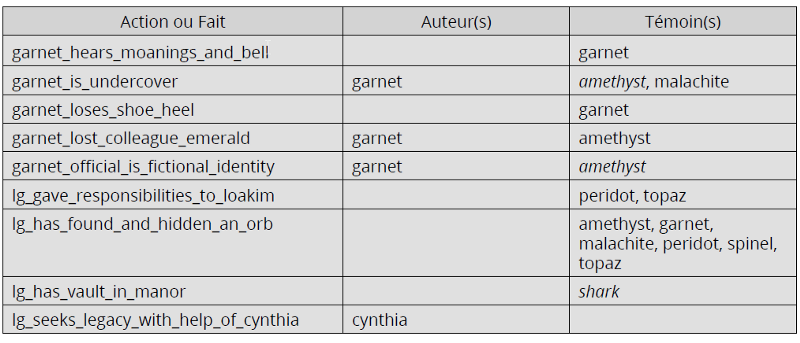
As a result, the game master can rely quietly on his own (self-generated) documents to set up and monitor the game: detailed scenario, evening planning, checklist of materials and writings to be placed in the premises, automatic summary of missions and special skills of each player…
On top of that, this machine can also send its game documents, by email, to each player (e.g. character card and documents initially owned). This avoids the drama that awaits each organizer: spoiling a participant by sending him the wrong documents.
This system obviously adds a certain complexity to the project, compared to some common Word/LibreOffice files. But it provides invaluable support in terms of scenario scalability and robustness, detecting inconsistencies and automating daunting tasks. Personally, he saved me more than once, when I switched the names of some characters in cards, or forgot to warn some players of the new misdeeds they were supposed to have committed in the past.
How to set up such a process?
Step 1: Move away from rich office files (docx, odt, pdf…) to a plain text format, easily manipulable, where the formatting is explicitly indicated by special characters. The documents in game with high graphic and typographical needs (posters, scrolls, newspapers…) can be left aside, in more usual office automation files: Word, LibreOffice, InDesign…
Example of plain text (restructuredtext format):
Manuel du Maître de Jeu
############################
.. contents:: Table des Matières
:depth: 2
Concept de la soirée mystère
================================
**Chrysalis:Mindstorm** est un huis clos entre `enquête
<https://fr.wikipedia.org/wiki/Enqu%C3%AAte>`_ criminelle et conflit
géopolitique, où des agents secrets et des civils de divers pays se
retrouvent face à un *redoutable* inspecteur de police, qui va les
pousser dans leurs derniers retranchements.
Rendering of this text once converted to PDF:
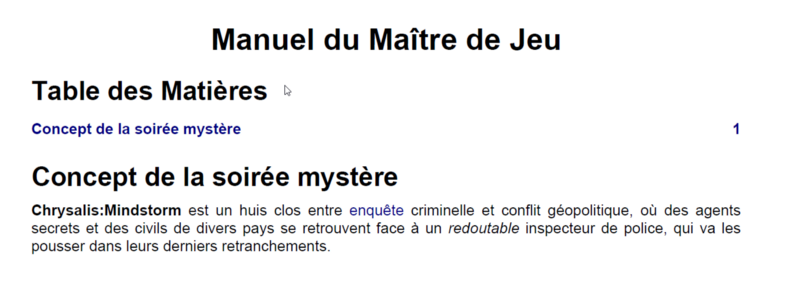
Step 2: Use a version manager for scenario files. This makes it possible to go back in time at any time, to avoid horrifying accidental file modifications, and to check the consistency of each of the changes made (renaming a place, adding information for a group of players…).
Viewing a change made to the rules of the game:
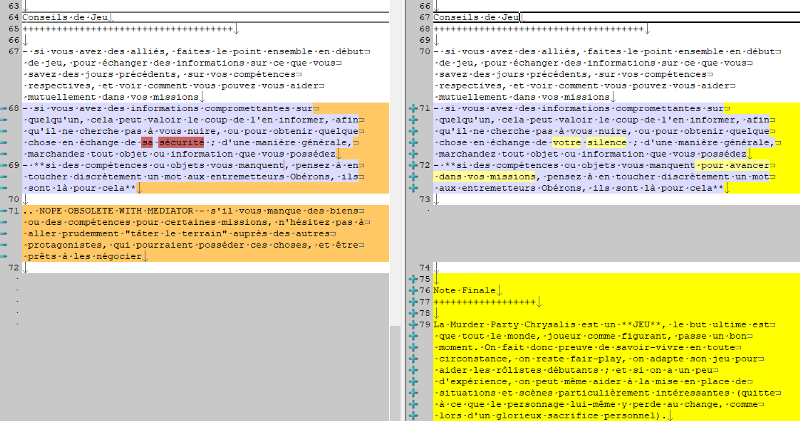
Step 3: Add a small processing engine, to enrich the text with simple and practical features: allow one file to include another, define reusable text blocks, insert variables (e. g. the date of a crucial event, different for each session of the mystery evening), display different information according to the team to which the targeted player belongs….
Step 4: Automate consistency checks. To do this, I created specific tags in the processing engine, which I then inserted as I wrote:
— The {% fact %} tag is used to announce a fact (e. g. “so-and-so tried to rob Loyd Georges”), and to indicate whether the player is the author or just a witness.
— The {% hint %} tag allows you to request the existence of a physical clue (letter, object…) to give to the player.
— The {% symbol %} tag ensures that a value is unique in all scenario files (e. g. the exact time of a crime), while avoiding the use of “variables” that obscure the text.
Example of using special tags to enrich a scenario text:
To the attention of {{agent_gamma_fake_name }} : the country of {% symbol “Balberith” for “first_country_at_war” %} has entered the war, following the plot led by agent Epsilon {% fact “agent_epsilon_triggered_war” as author %}. You have a testimony signed by him and attesting to it. {% hint “epsilon_signed_testimony_for_agent_gamma” is needed %}.
As we can see, these tags each have their own syntax, and can use other features of the processing engine, such as variables (of which we have an example with _{{agent_gamma_fakename }}).
Step 5: Link all this with scripts, which will automate the different steps of creating game documents: gathering useful data (including player photos), distributing scenario pages for each participant (global context, personal context, game rules…), transforming them into PDF format, and generating summary sheets for the game master.
Some of the PDF documents generated, next to their plain text sources:
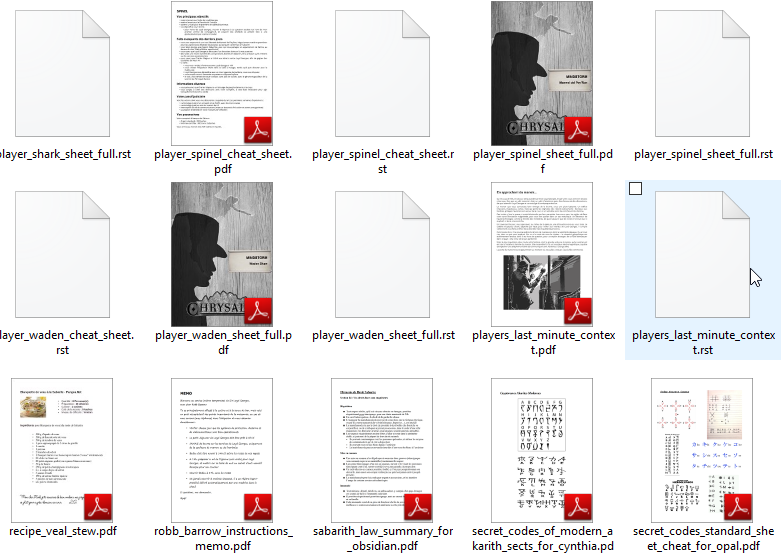
The future
All this is all well and good, but what about the rest of the role-playing community? Can it benefit, more broadly, from the functionalities offered by this scriptwriting support system?
The answer is yes. However, as seen in the steps above, this tooling requires a certain affinity with processes that are usually reserved for computer development; an affinity that many GN authors do not have.
I am therefore listening to authors tempted by the experience, in order to see with them how they work, what formats and tools they are able to use, and how this system could be generalized to suit their use. I could then see to extract this code (which is currently strongly linked to the structure of the Chrysalis game files), to make it more autonomous and more easily deployable.
Note that software such as Twine already allows scenarios to be created in a fairly simple way, with a mini-language to define variables and use logical operations. Pychronia Tools machinery therefore only makes sense for the very high level of integration it offers, with its automated consistency checks and end-to-end generation scripts.
Interested in this scriptwriting support system? Feel free to contact me using the information on the Chrysalis Website.
Appendix : Details for computer literate people
My machinery is based on the Python language and its document manipulation/creation ecosystem.
As for the “plain text” format of the scenario, many “markup languages” can be used for this purpose: restructuredtext, markdown, textile, latex, or even html… I chose restructuredtext for its clarity, versatility, and its advanced integration with the Python language. To edit these text files, of course, Pycharm, Notepad++, Geany, or a simple notebook can do the trick.
For the version manager (or “VCS”), I chose Git and its excellent TortoiseGit graphical interface (available under Windows only unfortunately). Mercurial, Bazaar, DARCS, or others are just as relevant. At a minimum, we can use the versioned file backup proposed by Dropbox et al., even if it offers only a few features to visualize the differences between several writing steps…
Visualization, via GIT, of the sets of modifications made to the scenario:
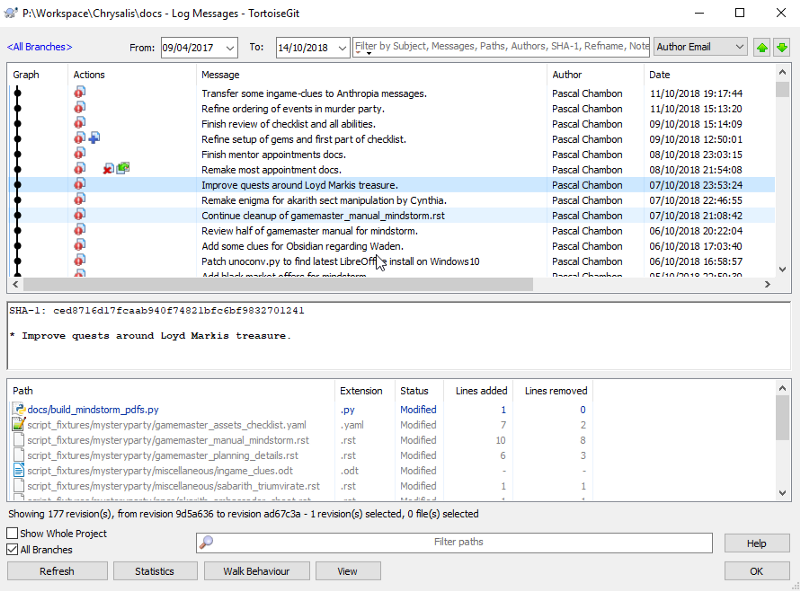
Regarding the template engine used to process text files (and for specific tags), finally, I have integrated the powerful Jinja2, which allows you to create variables and macros directly in the templates. The data handled by this engine comes, in my case, from a tree structure of Yaml files, but many other sources (python file, csv, xml…) are very easily integrated.
Subscribe to my newsletter
Read articles from freeCodeCamp directly inside your inbox. Subscribe to the newsletter, and don't miss out.
Written by

freeCodeCamp
freeCodeCamp
Learn to code. Build projects. Earn certifications—All for free.